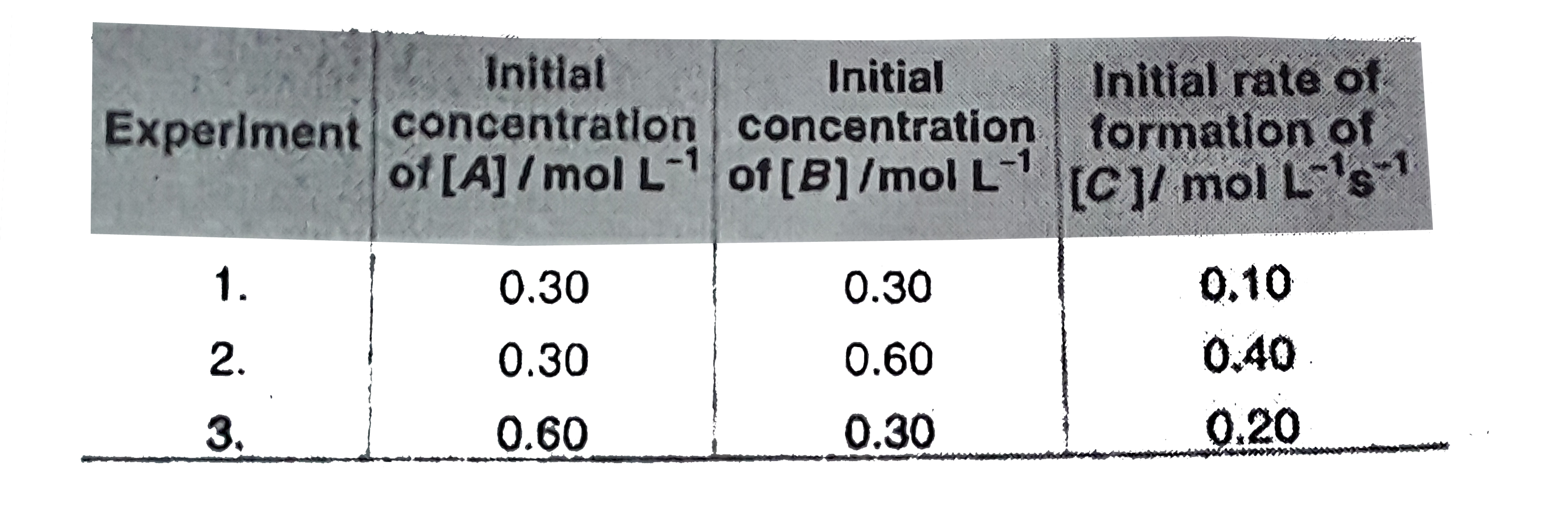Compounds .A. and .B. react according to the following chemical equation.
A(g)+2B(g)→2C(g)
Concentration of either .A. or .B. were changed keeping the concentrations of one of the reactant constant and rates were measured as a function of initial concentration .Following results were obtained.Choode the correct option for the rate equations for this reaction.

Rate=k[A]2[B]
Rate=k[A][B]2
Rate=k[A][B]
Rate=[K][A]2[B]0
The correct Answer is:B
Suppose the order of reaction in respect to A and B is x,y.
Rate r=k[A]x[B]y
Rate of exper(2)Rate of exper.(1)=(0.60)y(0.30)x(0.30)x(0.30)y=(0.60)y(0.30)y=2y
∴0.400.1=4.0=2y so,y=2
expt−3expt−1=Rate−3Rate−1=[A]x[B]2[A]x[B]2=0.200.10
∴(0.60)x(0.30)x×(0.30)2(0.30)2
∴2x=2∴x=1
So ,rate equation =k[A][B]2 option (B) is correct.
Topper's Solved these Questions
- CHEMICAL KINETICSBOOK - KUMAR PRAKASHANCHAPTER - CHEMICAL KINETICSEXERCISE - Section-D (Multiple Choice Questions (nore than one options))
12 Videos
- CHEMICAL KINETICSBOOK - KUMAR PRAKASHANCHAPTER - CHEMICAL KINETICSEXERCISE - Section-D (Short Answer Type Question)
20 Videos
- CHEMICAL KINETICSBOOK - KUMAR PRAKASHANCHAPTER - CHEMICAL KINETICSEXERCISE - Section-C (Textual Excercise)
29 Videos
- BOARD EXAM QUESTION PAPER MARCH - 2020 BOOK - KUMAR PRAKASHANCHAPTER - BOARD EXAM QUESTION PAPER MARCH - 2020 EXERCISE - PART -B
23 Videos
- CHEMISTRY IN EVERYDAY LIFEBOOK - KUMAR PRAKASHANCHAPTER - CHEMISTRY IN EVERYDAY LIFEEXERCISE - SECTION - E (MCQs ASKED IN GUJCET/BOARD EXAM)
37 Videos
Similar Questions
Compounds 'A' and 'B' react according to the following chemical equation.
A(g)→2B(g)→2C(g)
Concentration of either 'A' or 'B' were changed Keeping the concentration of one of the reactants constant and rates were measured as a function of initial concentration. Following result were obtained.
Choose the correct option for the rate equations for this reaction.

View SolutionCompounds 'A' and 'B' react according to the following chemical equation.
A(g)→2B(g)→2C(g)
Concentration of either 'A' or 'B' were changed Keeping the concentration of one of the reactants constant and rates were measured as a function of initial concentration. Following result were obtained.
Choose the correct option for the rate equations for this reaction.

View Solution
Knowledge Check
Compound 'A' and B react according to the following chemical equation.
A(g)+2B(g)→2C(g)
Concentration of either A or B were changed keeping the concentrations of one of the reactants constant and rates were mesured as a function of initial concentration. Following results were obtained. Choose the correct option for the rate equations for this reaction.
ExperimentInitial concentration of[A]/molL−1Initial concentration of[B]molL−1Initial rate of formation of[c]/molL−1s−110.300.300.1020.300.600.4030.600.300.20ARate =k[A]2[B]BRate =k[A][B]2CRate =k[A][B]DRate = k[A]2[B]0Compound 'A' and B react according to the following chemical equation.
A(g)+2B(g)→2C(g)
Concentration of either A or B were changed keeping the concentrations of one of the reactants constant and rates were mesured as a function of initial concentration. Following results were obtained. Choose the correct option for the rate equations for this reaction.
ExperimentInitial concentration of[A]/molL−1Initial concentration of[B]molL−1Initial rate of formation of[c]/molL−1s−110.300.300.1020.300.600.4030.600.300.20ARate =k[A]2[B]BRate =k[A][B]2CRate =k[A][B]DRate = k[A]2[B]0Compounds 'A' and 'B' react according to the following chemical equation
A(g)+2B(g)→2C(g)
Concentration of either 'A' or 'B' were changed keeping the concentrations of one of the reactants constant and rates were measured as a function of initial concentration. Following results were obtained. Choose the correct option for the rate of equations for this reaction.
 ARate of = k[A]2[B]BRate = k[A][B]2CRate = k[A][B]DRate = k[A]2[B]−
ARate of = k[A]2[B]BRate = k[A][B]2CRate = k[A][B]DRate = k[A]2[B]−
Compounds 'A' and 'B' react according to the following chemical equation.
A(g)→2B(g)→2C(g)
Concentration of either 'A' or 'B' were changed Keeping the concentration of one of the reactants constant and rates were measured as a function of initial concentration. Following result were obtained.
Choose the correct option for the rate equations for this reaction.

View SolutionCompounds 'A' and 'B' react according to the following chemical equation.
A(g)→2B(g)→2C(g)
Concentration of either 'A' or 'B' were changed Keeping the concentration of one of the reactants constant and rates were measured as a function of initial concentration. Following result were obtained.
Choose the correct option for the rate equations for this reaction.

View SolutionCompounds 'A' and 'B' react according to the following chemical equation.
A(g)→2B(g)→2C(g)
Concentration of either 'A' or 'B' were changed Keeping the concentration of one of the reactants constant and rates were measured as a function of initial concentration. Following result were obtained.
Choose the correct option for the rate equations for this reaction.

View SolutionCompounds A and B react according to the following chemical equation :
A(g)+2B(g)→2C(g)
Concentration of either A or B were changed keeping the concentrations of one of the reactant constants and rates were measured as a function of initial concentration, Following results were obtained.

Choose the correct option for the rate equations for this reaction.
View SolutionCompounds A and B react according to the following chemical equation :
A(g)+2B(g)→2C(g)
Concentration of either A or B were changed keeping the concentrations of one of the reactant constants and rates were measured as a function of initial concentration, Following results were obtained.

Choose the correct option for the rate equations for this reaction.
View Solution
